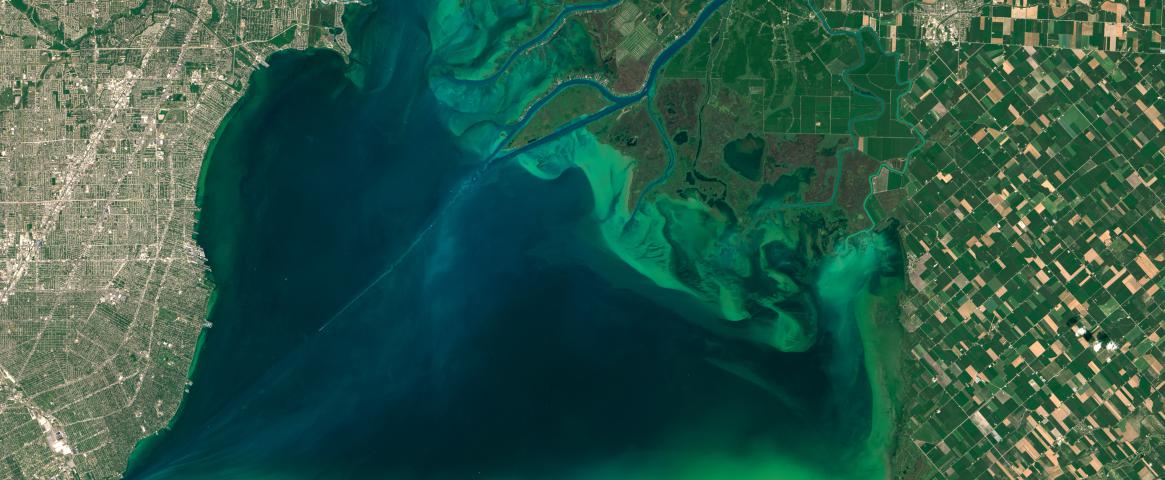By Emma Denes. Mentored and edited by Mark Shwartz.
What happens in the ocean stays in the ocean. Or does it? It turns out that climate change and other human impacts on aquatic ecosystems also accelerate health risks for those living near rivers, lakes and marine coastal areas.
That’s the finding of a Feb. 20 scientific panel that explored the relationship between water and human health at the annual meeting of the American Association for the Advancement of Science. The panelists discussed the importance of engaging coastal communities affected by human impacts, such as microplastic pollution and harmful algal blooms (HABs).
HABs occur when uncontrollable algae populations flourish, resulting in the production of toxic chemicals that damage both humans and marine life. Saltwater and freshwater HABs are exacerbated by the changing climate, whether from warmer temperatures that fuel the toxins released by algae or the nitrogen-rich nutrient runoff that increases with stronger storm systems. And HABs are more common than ever, especially in the Great Lakes.
“Ten years ago, these blooms would be absolutely unthinkable,” said George Bullerjahn, director of the Great Lakes Center for Fresh Waters and Human Health. “But now we're seeing blooms occurring.”
Algal blooms expose humans to harmful toxins through a variety of channels, such as consuming seafood or coming into contact with contaminated water. And when ingested, these toxins can result in paralysis, diarrhea and even death. In 2014, an algal bloom caused by agricultural runoff in Lake Erie was responsible for a water crisis in Toledo, Ohio, that deprived almost half a million people of access to clean drinking water.
“In the last 15 years or so, there is emerging data that shows that many harmful algal bloom toxins … can actually affect human health adversely because of either acute exposure or chronic exposure,” said Saurabh Chatterjee, director of the University of South Carolina’s Environmental Health and Disease Laboratory.
One example is the exposure of young people to microcystin, one of the most common freshwater HAB toxins, which is associated with the development of both nonalcoholic fatty liver disease and chronic liver disease. Chatterjee's lab has found preliminary data suggesting that microcystin exposure leads to antibiotic resistance and an increased intensity of vibriosis, a potentially fatal bacterial infection caused by eating raw or uncooked shellfish.
“There are communities that are new that are experiencing harmful algae blooms, maybe for the first time, and don't understand the risk or how to protect themselves from risk,” said Jennifer Pierce of The Greater Caribbean Center for Ciguatera Research. Her organization focuses on ciguatera, which is the “most common form of algal-induced seafood poisoning,” according to the National Oceanic and Atmospheric Administration.
Microplastics, small pieces of plastic debris less than five millimeters long, can also harm aquatic life and people. Algal toxins can adhere to these tiny plastic particles, and as the particles move up the oceanic food chain to our plates, they can end up in our digestive system, carrying the toxins into our bloodstream, added Chatterjee.
Mitigation of HABs and microplastics is possible, but requires a combination of strategies, from sample analysis to buoy sensor technology, according to the panelists. But non-scientists also play a powerful role. For instance, Bullerjahn's team collects much of its data from charter boat captains on Lake Erie, who assist with research efforts. “That shows how citizen science not only gets people engaged, but also takes ownership of their own pot,” he said.
According to Pierce, the crucial piece of the puzzle for improving marine and human health lies in educating, informing, alerting and involving individuals and groups, including those in medical communities, about environmental health issues. That effort can take a variety of formats, from combating disinformation to educating medical students to emphasizing vulnerable populations.
“The main thing is connecting folks to government officials and to create communities and committees of preparation,” she said. “And ultimately get the folks in need of that information back to their regular life and their regular enjoyment.”
We rely on the environment, and the environment relies on us, so it is vital to protect the well-being of every party involved, the panelists concluded. “We talk about the One Health concept, the concept that a healthy environment creates a healthy natural world creates a healthy human world, and then all three of those are connected, and we have to remember those relationships,” Pierce said.
Emma Denes is a freshman Communication student at Marist College in Poughkeepsie, N.Y. Along with her passion for marine biology, she is pursuing a double concentration in Journalism and Communication Studies and a double minor in Environmental Studies and Psychology. She currently serves as a staff writer for the Marist Circle and as a member of the Marist Campus Sustainability Advisory Committee. You can follow her on Twitter @byemmadenes or email her at emma-isabel@outlook.com.
Image: With climate change comes increased health issues for humans, such as harmful algal blooms in freshwater and saltwater ecosystems. Credit: NASA Earth Observatory




